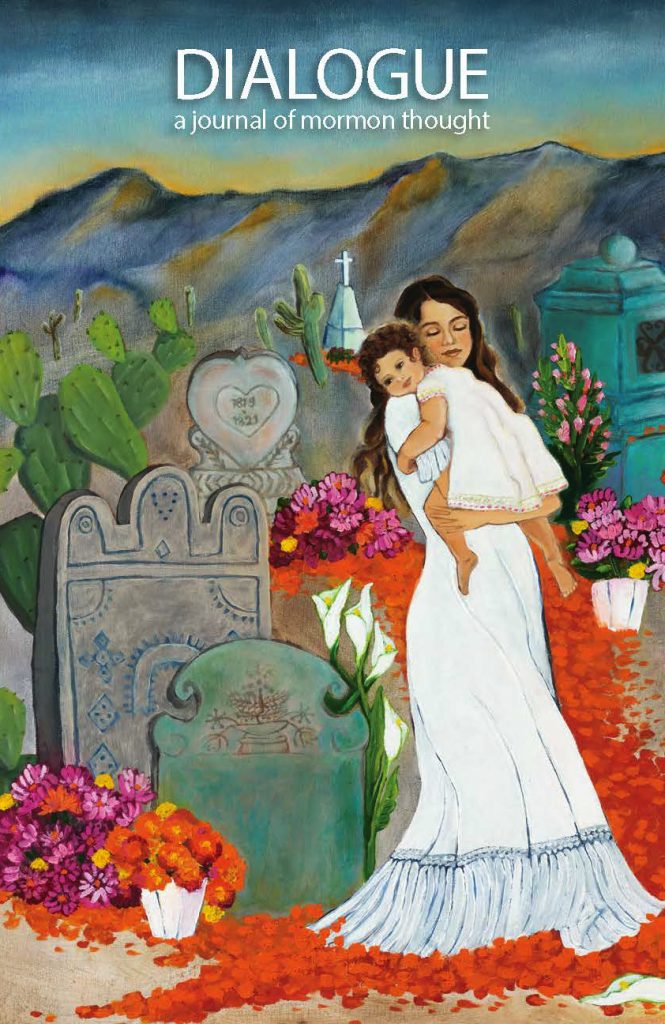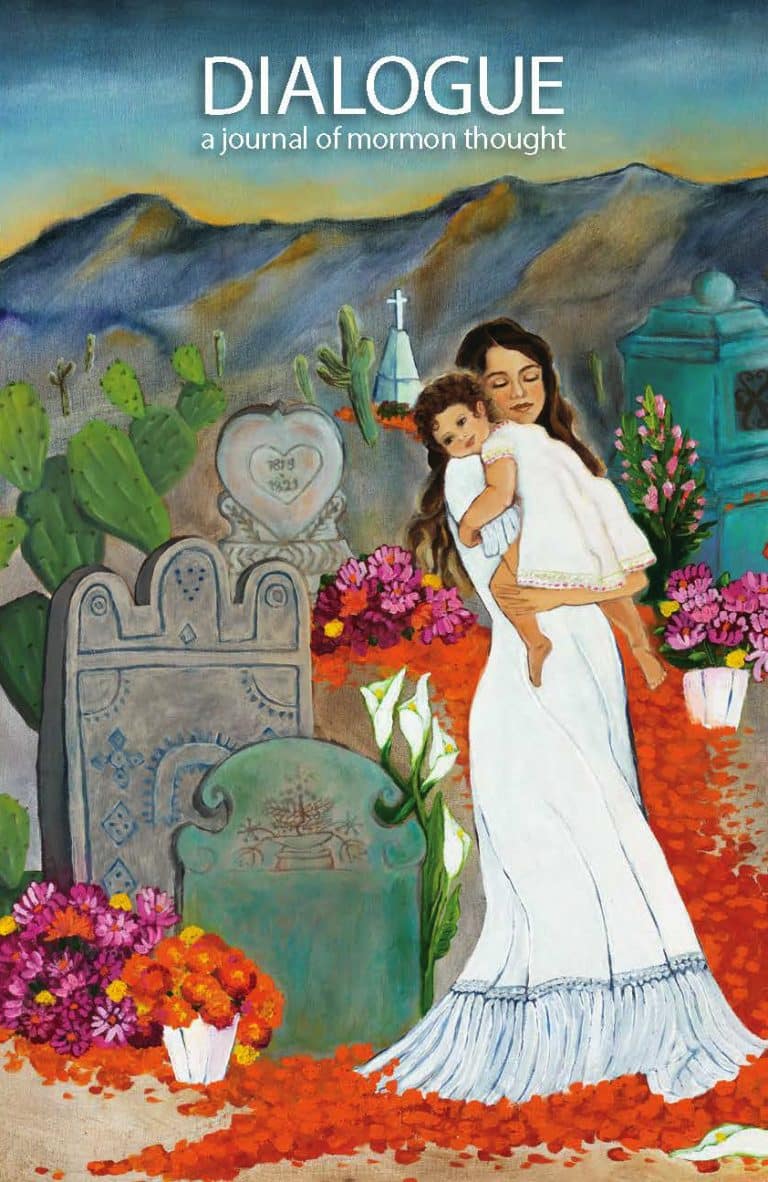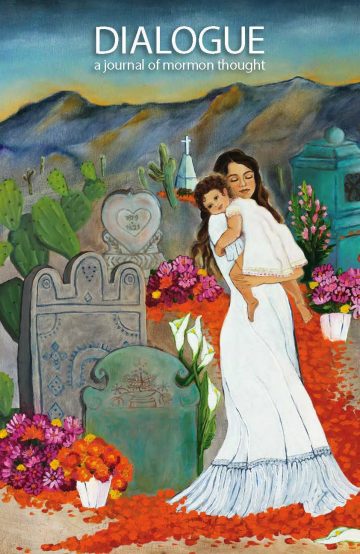
The Dialogue issue guest-edited by Exponent II came out recently. I feel so proud of the dozens of women who organized, wrote, and edited this beautiful collection. Like the “pink issue” of 1971— the first time Exponent women guest-edited Dialogue— I believe that this issue will stand as an historical marker of Mormon feminism. As the https://exponentii.org/wp-content/uploads/2021/12/IMG_5173-scaled-1.jpg of this issue, I wanted to share what stood out to me about each article. I also want to recognize and give huge thanks to Nancy Ross, who edited the academic essays; Dayna Patterson, poetry https://exponentii.org/wp-content/uploads/2021/12/IMG_5173-scaled-1.jpg; Mette Harrison, fiction https://exponentii.org/wp-content/uploads/2021/12/IMG_5173-scaled-1.jpg; and Hannah Pritchett and Tania Lyon, book review https://exponentii.org/wp-content/uploads/2021/12/IMG_5173-scaled-1.jpgs.
ACADEMIC ESSAYS
Multiculturalism as Resistance: Latina Migrants Navigate U.S. Mormon Spaces
By Brittany Romanello
This is social science academic writing done in the best way: with ethnographic details woven through, bringing the overall thesis to life. Through extensive interviews, Romanello tells the stories of Latina women inhabiting the mostly white American Mormon spaces and how deeply they rely on their Latinx communities to navigate that world. Through amplifying the voices of Latina Mormons, Romanello has created a must-read piece for anyone interested in how the Church can assist those who “face intersecting societal disadvantages.”
The Other Sin: Abortion and Contraception in Nineteenth- and Twentieth- Century Utah
By Amanda Hendrix-Komoto
If you ever believed that LDS women have had a consistent or unified stance on abortion, this essay will blow your mind. Hendrix-Komoto looks at the general understanding of what a fetus was in the 19th century and examines advertisements from Mormon men who sold abortion pills at the time. The way we understand pregnancy—what pregnancy is, when it starts, and what it means—has fundamentally changed over the decades. In order to have productive, vigorous conversations on the topic now, we need to understand those changes.
Women’s Lived Experience as Authority: Antenarratives and Interactional Power as Tools for Engagement
By Emily January Petersen
Emily January Petersen uses the idea of antenarratives, or “fragments of experience” that push up against dominant narratives. People whose lived experiences contradict that dominant narrative may find intense social or institutional power pressuring them to remain silent. However, the employment of antenarratives is a powerful way for individuals to challenge the norms that marginalize them.
PERSONAL ESSAYS
The Blessing I Took
By Lindsay Denton
Denton tells the story of first asking for permission, and then insisting on her own personal authority to hold her infant son while he is blessed. This has been a recurring topic within Mormon feminism for many years, but Denton’s poignant writing makes the issue particularly powerful. Readers follow her personal journey of claiming authority and are also left to ponder the question she asks: Do we believe that a mother’s touch will invalidate a blessing of God?
The Power of an Unbroken Woman
By Joy Sitawa Richards
This essay tells the heartbreaking and hopeful story of Richards’ path from a young woman, to a wife and mother suffering from severe domestic violence, to immigrant, survivor, and college graduate. Richards candidly shares how her personal power is rooted in faith and family and how those things carried her through “the great storms of [her] life.”
The Stories We Tell—And What They Tell Us
By Heather Sundahl
Sundahl has long been famous in the Exponent II organization for her storytelling. In this piece, she explains how the way we choose to tell our own stories has direct implications for our health and happiness. There are many ways to tell the same story and what details we choose to focus on will change our lives.
The Order of Eve; A Matriarchal Priesthood
By Kyra Neipp Krakos
When biology and Mormon feminism mix, the result is an essay that explains how mitochondrial DNA give women the right to perform blessings. Krakos’ piece is both funny and moving as she describes the science and theology that led her to give her mother a blessing of comfort.
For the Power is In Them: Leonard Arrington and the Founders of Exponent II
By Laurel Thatcher Ulrich
Leonard Arrington played a vital role in the rebirth of Mormon feminism in the 1970s. In this essay, Ulrich gives a history of his support for the early Exponent II founding mothers and also lays out how his private diary documented the work of women during that time.
Women in Dialogue
By Claudia Bushman
Bushman edited the “pink issue” of Dialogue in 1971 and has long been personally involved in both organizations, making her well-positioned to write about the relationship between them. This essay documents the making of that issue and looks at the potential future of Mormon feminism moving forward.
INTERVIEWS AND CONVERSATIONS
Mormon Women in the Ministry
Edited by Emily Clyde Curtis
This roundtable interview is one of the most extraordinary pieces I have ever read in Mormon feminism. Clyde Curtis brought together Mormon women who have been ordained and discussed what called them to the ministry and what it looks like in their lives. Included are women who have left the LDS Church in order to become pastors, one woman who is simultaneously active and engaged in her local LDS congregation while also working as an Episcopal chaplain at the National Cathedral School, and a woman who left her career as an Anglican pastor in order to be baptized into the LDS Church.
Women in Workplace Power
Edited by Barbara Christiansen
As working outside the home has normalized for Mormon women in recent decades, we find ourselves with the first generation of Mormon women who are acting in roles of institutional power in their careers. This group of women discuss mentorship, engaging comfortably in positions of power, and how leadership roles in their careers have affected their religious lives.
POETRY
The collection of poetry in this issue forms a satisfying arc of Mormon feminist theology. Editor Dayna Patterson brilliantly brought together individual pieces that shine on their own and also contribute to a broader whole. Rather than attempting to describe each one separately, I’ll just strongly encourage you to read through them all and in the order printed.
FICTION
The Garden of Babel
By Luna Flesher
It’s hard to summarize a piece set in the multiverse, in a land governed by a woman and including a conversation with Heavenly Mother that explores agency, adversity, and the Problem of Evil. Flesher’s brilliant writing made this piece one of my favorites. Read it.
The Nape of the Neck
By Keira Shae Sholz
What does it mean for women to claim authority over their own bodies? This story subtly explores the restrictions placed on women’s bodies and invites women to consider defying them. The story also looks at the role of the human body in art and how we need to rethink shame.
BOOK REVIEWS
Editors Hannah Pritchett and Tania Lyon wanted to do this section a little differently and chose to broadly explore the theme of women claiming power through reviews of fiction and non-fiction books. As they write, “Our book reviews explore the theme of women negotiating imbalances of power as well as claiming power in their lives and in their narratives. The reviews deliberately venture into genres that are popular with readers but less represented with reviewers, take a broader view of a field, or re-examine older publications with a new lens. The results are often unexpected, both in the effects they aim for and how they choose to achieve them. While some women use power to control, others use it to forgive, to fall in love, to follow freedom, or to find faith.”
ART NOTE
Symbols on Canvas
By Lita Little Giddins
The art that graces the cover of this issue of Dialogue is jaw-droppingly good. Michelle Franzoni Thorley is one of the rising stars of Mormon art. In this piece, Giddins examines Thorley’s artwork “Family History and Temple Work” through the lens of being a fellow female Mormon artist of color. She describes the immediate connection she had with Thorley when they met last year and how the symbolism that Thorley uses in her art convey particular meaning for her. Having been lucky enough to have spent some time in a room with Giddins and Thorley together, I strongly recommend getting a peek at the brilliance that emerges from these two women.
FROM THE PULPIT
The Gebirah and Female Power
By Amber Richardson
There are a few pieces I’ve read over my years as an https://exponentii.org/wp-content/uploads/2021/12/IMG_5173-scaled-1.jpg that make me cry every time I read them, even after dozens of read-throughs. This is one of them. Richardson boldly reviews the story of Bathsheba and what happened to her after her infamous first encounter with David. Richardson doesn’t limit herself to defending and exonerating Bathsheba, she also uses the Song of Solomon to acknowledge Bathsheba’s spiritual power. While this piece will particularly resonate with anyone who has experienced sexual violence, it is also a must-read for all Mormons who care about how we talk about women in scripture.
Again, I want to express my gratitude for the many women who worked so hard on this issue. I’m extraordinarily proud of it. Go read the whole thing (for free!) at www.dialoguejournal.com.




2 Responses
As a supplement, please listen to the Dialogue Book Report Podcast, where we discuss the beautiful reviews found in the new Dialogue Spring 2020 Issue, guest edited by Exponent II. I talk to Margaret Hemming Olsen about the issue, and then, with Hannah Pritchett (guest Book Review Editor), we interview Ashley Mae Hoiland about her new books. https://www.dialoguejournal.com/podcasts/dialogue-book-report-3/
Love this!! Every article I’ve read so far has been wonderful. Thank you!